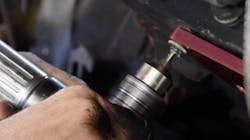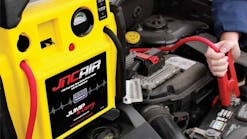Guest Blog: Three drilling tips for technicians
Automotive and diesel technicians today need a wide variety of skills to get cars, trucks, and fleets back on the road and running at peak performance. One skillset that takes constant refinement is operating a drill. This skill is most commonly used when a technician finds themself behind a broken bolt that needs to be extracted. Whether by hand or on a press, understanding the anatomy of a drill and knowing best practices will save time and money over and over again as a technician. Here are three drilling tips that we recommend every technician takes the time to understand and develop.
1. Speed
Don’t max out the RPMs. This is not a race. The number one factor that is going to wear out or break drill bits is speed. A general rule of thumb is the harder the metal, the slower the drill speed. The hardness of the tooling that is being used will also impact the recommended cutting speed. The harder the drill, the faster the cutting speed.
Always follow the instructions that are included with the tooling – the last thing the technician wants to do is “work harden” metal they are attempting to drill through. Work hardening is the result of exposing your cutting surface to friction and thus heat, resulting in the metal hardening even further and making it more difficult to drill through.
2. Pressure
When drilling through hardened metals (or any material), thinking about the physics of the process will pay dividends. The technician is using a hardened, sharpened bit to drill through another material. Let it do its job, which is to cut the hardened metal, then extract it via the flutes on the tooling. Apply pressure, then pull it back out, clearing the cutting area of shavings which can build up, creating torque and pressure which will cause the tooling to break and dull.
Heat and friction are other factors that need to be considered while drilling. By applying a drill lube or cutting fluid, the technician can reduce friction and heat that their tooling is exposed to while cutting through harder metals like steel. A little bit goes a long way. In addition to cooling down the drill job, cutting fluid will allow for a cleaner cut and allow their harder (and more expensive) tooling to last much longer.
3. Drill bit quality
Tooling isn’t created equally. There are two main features that will determine the quality of a drill bit. The material and the design.
Drill bits can be made of high-speed steel, cobalt, or carbide. Each more expensive to produce than the last – yet each also capable of cutting harder materials than the last.
The design of the drill bit is equally important to the quality. One of the main design variants in drill bits is the drill point angle. The industry standard is between a 118-degree and 135-degree drill point angle. The 118-degree has a more aggressive cutting edge, whereas the 135-degree isn’t as steep, slowing down the drilling process. When cutting through harder materials, a 135-degree drill point angle is going to be necessary to cut through the hardened metal before dulling or breaking the tooling.
Technicians are always looking for more ways to become more productive. ProMAXX Tool's main objective is to provide these technicians with tools and knowledge that make them more productive and confident professionals that can tackle any job that comes their way.
Information provided by ProMAXX


